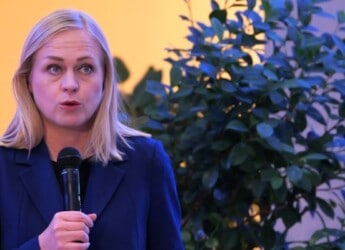Background Note: This reposting highlights the Dr. Seuss story “Too Many Daves,” which is about a family with too many children, all named Dave, and how it becomes difficult for the parents to keep track of and distinguish between them. Similarly, in the digital media realm of eDiscovery, there may be too many voices sharing non-substantive information, making it difficult for professionals to distinguish between valuable contributions and those that may be less meaningful.
In the story, the parents struggle to keep track of which Dave is which and to remember their unique characteristics. Similarly, in the eDiscovery field, there may be an over-presentation and overexposure of information and personalities, making it difficult for professionals to break through the digital clutter to keep track of which people, processes, and protocols are truly innovative, valuable, and effective. This can lead to a lack of critical evaluation, and a tendency to rely on the opinions and preferences of a select group of individuals or organizations.
The story also highlights the importance of individual characteristics and personalities, with the Daves all being different and having their own unique characteristics. In the context of eDiscovery, this may be interpreted as the importance of diversity of thought and perspective in the field. It is important for professionals to seek out and critically evaluate the ideas and perspectives of a wide range of individuals and organizations, rather than relying solely on the opinions of those who may be most visible or vocal in the digital media realm.
Neuroeconomics is a field that combines neuroscience and economics to study decision-making and behavior. In the context of high-velocity digital media usage in the eDiscovery industry, neuroeconomics can be applied to understand how the rapid sharing of information by organizations and individuals may be impacting the ability of individuals to engage in critical thought and make effective decisions based on the information shared. This use of neuroeconomics might include studying how the sheer volume of information available, the speed at which it is shared, and the way it is presented may affect cognitive processes such as attention, memory, and decision-making. Additionally, researchers might examine how individuals’ emotions and motivations influence their behavior and decision-making in the context of eDiscovery, and how the design and use of digital media platforms and tools may shape these processes.
In the following article, “A Few More Minutes for Sale: Why Attention Is A Scarce Resource And How Media Organizations Can Use Neuroeconomic Wisdom To Buy More of It,” author Chilumba Bwalya from the University of Zambia uses neuroeconomics and business perspectives to help readers consider and understand the impact of media products and services on decision-making, with a focus on news, advertising, and other media outputs in the digital age. It examines how the availability and accessibility of these outputs can affect consumer behavior. The article may be important to cybersecurity, information governance, and legal discovery professionals exposed to the explosion of digital media outputs ranging from podcasts and posts to presentations and pronouncements as they consider and ultimately are influenced – positively, neutrally, or negatively – by the digital media outputs in today’s online environments.
Content Assessment: 'Too Many Daves' in eDiscovery? How High Velocity Online Sharing May Be Undermining Critical Thought in the Industry
Information - 92%
Insight - 91%
Relevance - 90%
Objectivity - 92%
Authority - 92%
91%
Excellent
A short percentage-based assessment of the qualitative benefit of the post highlighting a recent article published in Academic Letters on the impact of digital media on attention and decision-making in online environments.
Educational Paper on Neuroeconomics*
A Few More Minutes for Sale: Why Attention Is A Scarce Resource And How Media Organizations Can Use Neuroeconomic Wisdom To Buy More of It
By Chilumba K. Bwalya
Abstract
Neuroeconomics seeks to explore economic decisions and understand the mechanisms of decision-making and action. The classic economists lucklessly view such a complex undertaking as not a conscious composition of value judgment but instead of surface computational processes. This lack of appreciation of the humanistic approach to conjure the neurological and psychological impact of decision-making brings us to the crossroad of understanding what is going on in the minds of consumers of multimedia. Could it be attention problems, or is it that we have sifted through what matters and found a niche for what suits our test?
At the center of all the hubris behavior among economists, neuroeconomics, behavioral psychologists and the common ’wanna-be’ is the survival and continued existence of a field that started as a form of daily notice in 59 BCE. The thesis that transcends the debate for survivals is, how can we buy a few more minutes of attention through multichannel multimedia and journalism to save an industry of great importance from digital annihilation and complete obliteration?
This paper takes neuroeconomics and the general business dimension to inform and contribute to an appreciation of the consumer of media products and services. It speaks to how decision-making and pays particular attention to media productive outputs such as news, advertising from traditional formats in the wake of the mighty digitization, and accessible media sources can impact.
A Few More Minutes for Sale - Neuroeconomics
Reference: Bwalya, C. (2021). A Few More Minutes for Sale: Why Attention Is A Scarce Resource And How Media Organizations Can Use Neuroeconomic Wisdom To Buy More of It. Academia Letters, Article 3620. https://doi.org/10.20935/AL3620.
*Open Access – Distributed Under CC BY 4.0
Postscript: The high-velocity sharing of podcasts, posts, presentations, and pronouncements by industry associations and commentators in the eDiscovery field may be undermining the ability of professionals to evaluate and critically consider innovation, individuals, and insights that may reside outside of the circle of highly visible, prolific participants in the digital media realm for several reasons:
- Overload of information: The sheer volume of information shared at a high velocity may lead to information overload, making it difficult for professionals to process and evaluate all of the information they are being presented with. This can lead to a lack of critical analysis and less thoughtful decision-making.
- Groupthink: The concentration of highly visible, prolific participants in the digital media realm may lead to a tendency for others to adopt similar perspectives, leading to a lack of diversity of thought and less critical evaluation of new ideas and perspectives.
- Limited exposure: The high visibility of certain individuals and organizations may lead to a bias towards their ideas and perspectives, while potentially overlooking valuable contributions from others who may not be as visible in the digital media realm.
- Confirmation bias: The rapid sharing of information may also lead to a confirmation bias, where people tend to seek out and give more weight to information that confirms their existing beliefs, instead of critically evaluating new ideas and perspectives.
It is important for eDiscovery professionals to be aware of these potential biases and make an effort to seek out diverse perspectives and ideas, both within and outside the circle of highly visible, prolific participants in the digital media realm.
Assisted by GAI and LLM Technologies
Additional Reading
- Experiencing an Info Glut? Taming Information Overload
- Balancing eDiscovery Consumption and Creativity? Considering Economic Psychology
Source: ComplexDiscovery OÜ



























